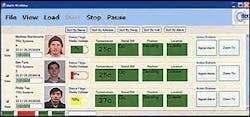COLLEGE PARK, Md.-- Through the use of emerging technology, a group of engineers at the University of Maryland-College Park are attempting to advance firefighter locator and tracking systems to the next level.
The April 26 symposium held at the Maryland Fire Rescue Institute, located adjacent to the university, showcased several projects currently in development. Many in attendance would argue, however, that TRX Systems Inc. -- which is part of the university's technology advancement program -- stole the show.
The TRX Sentinel locator and tracking system takes the concept of a global positioning system (GPS) and brings it indoors.
According to the project's president, Dr. Neil Goldsman, the indoor environment is totally GPS denied since the system works exclusively off of satellites.
"Our team has used state-of-the-art MEMS (Micro Electronic Mechanical Systems) devices that only have come on the market within the last few years," Goldsman explained. "This new technology has allowed us to design a brand new system that allows you to track firefighters."
Through the combination of MEMS systems with micro computers and sophisticated mathematics, the group has developed its own system that has the ability to track the movements of firefighters through mapping software.
Although the process sounds complicated, Goldsman insists that the system is very user friendly.
"I told (the engineers) to make it as easy to use a bank ATM machine," he said. "You don't have to set up anything; all you have to do is open up the base station laptop and you're ready to go. The system will then track essentially where the team is going."
Through the use of two devices, information is sent to the laptop operated by a officer from the fire truck or other location. An Inertial Navigation Unit, or INU, is worn on the firefighter's belt while the Communications and Sensor Motherboard, or CSM, is carried in the breast pocket of the turnout gear.
Information such as a firefighter's location and specific movements are sent from a Bluetooth transmitter located in the INU to the CSM, which acts as a radio device and sends the information to the base station laptop.
A program on the laptop displays information for each firefighter including their name and photo, ambient temperature and status. Coupled with a mapping system, each firefighter is easily identified while moving through a structure.
When attempting to find the best way to incorporate maps into the program the group encountered various obstacles. Unlike GPS technology, most maps are generated from floor plans, and in some instances, floor plans are not available.
In that case, a map is generated as the firefighters make their way through the building, but it becomes more difficult to track them.
"The process of tracking people on a map is very difficult; a lot tougher than we first thought," TRX Systems Chairman Gilmer L. Blankenship said.
During a live demonstration of the TRX Sentinel, firefighters wearing the gear entered the outside of the building in search of a down firefighter. The firefighters were represented by dots on the map and were given instructions by radio of where to find him.
Within seconds the firefighters where guided to his location.
In some instances, the roaming firefighters appeared to be walking through walls on the map display, but the path eventually snapped back to the map. This is one issue the group hopes to work on. One firefighter in attendance equated the appearance of the computer program to a slow moving version of the Pac-Man video game.
While there is progress still to be made for the TRX Sentinel before it is ready for the market, MFRI Director Steven T. Edwards said that its successes are evident.
"This is not the final product yet, it is still under development, but where the progress is made, and where this is going to go in the near future is extremely important," he said.
"This represents the future of firefighter safety. You look at the firefighter fatalities throughout the country and there are trends," he said. "(Firefighters) are disoriented, they come into an area of the building where they get away from their crew and the hose line where no one knows where they're at.
"You might have a few minutes to attempt a rescue and to have that location and direct a rescue team to that specific location is a huge step forward."
Edwards said the project has been in the works for close to three years and that it should at least two more years to get it ready for the marketplace.
"I believe we're ahead in the game and are developing products that are affordable, accessible and that work; that's the key," he said.
Edwards also noted that the TRX Sentinel project was funded in part of $825,000 FIRE Act grant received last year.
"With FIRE Act money you can either invest in one fire truck or something that will benefit the fire service across the country," he said. "This is a great example of leveraging that money."
The Congressional Fire Services Institute's Executive Director Bill Webb said the expansion of FIRE Act grant uses has allowed organizations such as MFRI to develop technologies that would otherwise go unfunded.
"It's definitely a good use of federal funding, there's no question about that," he said. "It's the type of stuff that we should have had yesterday.
"Steve was a big advocate in allowing grant money to be used for this type of funding. It is fascinating stuff and I hope that more people get exposed to the type of things they are doing."
Also presented at the symposium was the "Heads Up" SCBA temperature display by Dr. Marino DiMarzo and Dr. Amr Baz; the Firefighter 'Mayday' personnel accountability system by Grace Industries and presentation on the advances in human patient simulation by MFRI's Angela Bennett.
Related Links






